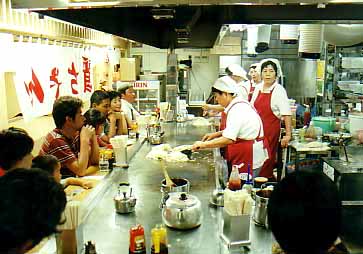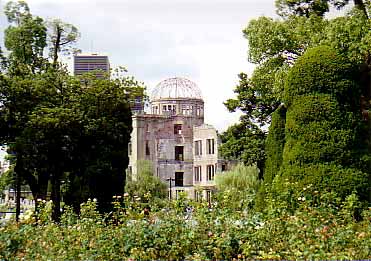
| Main Page |
| Photo Galleries |
| Writing |
| Aikido |
| Zen |
| Peeps |
| Links |
| Contact |

Hiroshima
 |
One of the cheapest ways to travel during the summer months in Japan is using the ju-hachi kippu, or 'eighteen ticket'. The ticket is a cheap multipass for the train that lets you travel an unlimited distance for 24 hours each time you stamp it. The catch is that you can only travel by local trains.
After looking at the staggering prices for bullet train tickets to Hiroshima, Laura and I decided that the only way to go was the ju-hachi kippu.
The trade off is that even though you may save a bundle by travelling on the local trains, it will take most of your natural life to reach your destination. The ride to Hiroshima took us about six hours, and the trip on the way back was about eight hours. The key, apparently, is to time it so that as you reach each station the next train will be there, but in my case, I was totally unable to comprehend the massive tome that is the train schedule for all of West Japan.
 |
One advantage to taking the local trains is that it gives you a chance to see a bit - well, let's be honest, a lot - more of the countryside that you are travelling through.
Because you are on the local trains, you also catch the Japanese in their everyday routines all along the way, and can begin to see the subtle differences between the peoples of different regions.
Although it is a small country, it is one of great variety, with significant differences in food and dialect from city to city (even if they are right next to eachother). Laura and I watched as the make-up, high heels and mini-skirts of Kyoto gave way to the sneakers, jeans and t-shirts of Okayama. The language softened, going from Kyoto's guarded undertones and Osaka's harsh staccato to the easy, measured sound of the Hyogo people.
|
Customers wait anxiously as the delicious okonomiyaki is fried up on the counter in front of them. |
Eat it and beat it: this was a pretty hectic place, and the people you can see standing in the background are actually part of a crowd waiting to get in. |
Our first experience with the people of Hiroshima was at an Okonomiyaki place in the train station that is widely renowned for it's excellent food. Although Okonomiyaki (literally "Fried-as-you-like"; a pancake with meat, veggies and whatever else they can think to put in) is popular throughout Japan, it is done very differently from region to region.
At this restaurant we found out two things; the Hiroshima dialect is much easier to understand, and Hiroshima-style okonomiyaki is fantastic.
 |
With our bellies full and both of us glad to be off the trains, Laura and I hit the streets of Hiroshima.
We were headed to the Hiroshima Peace Museum, and as such found ourselves slightly self-conscious for the first time about being foreigners. I mean, what must be the image of foreigners that people in this town which had an Atomic Bomb dropped on it? One would expect bitterness, hostility, anger.
But those things are not to be found in Hiroshima, a city that has rebuilt itself as a 'City of Peace'. People were friendly helpful, and altogether positive towards us...including the strange smiling man on the tram who got our attention by sticking a pack of cigarrettes to his head before coming over and naming all of the American Presidents that he could remember.
|
Known as the 'A-bomb Dome', this is the building that stood at ground zero when the bomb dropped at 8:15 am, August 6, 1945. |
A young girl, Sadako Sasaki, who was dying of Leukemia following the atomic bombing, believed that if she could fold 1000 paper cranes she could make a wish. Today, monuments all around Hiroshima are covered in garlands of cranes folded by schoolchildren all over Japan wishing for peace. |
The Hiroshima Peace Museum gives the visitor a chilling look at the effects of a nuclear blast, and gives information on the state of nuclear arsenals today. The museum luckily
 |
thought better of whitewashing over the agressive role of the Japanese in the Pacific, and is quite evenhanded in its criticism of Japanese militarism. The avowed purpose of the museum is not to assign blame, but to try to ensure that such horror is never visited upon any other civilization. After having visited twice now, I can only hope that they are successful in this.
'Highlights' in the museum include the steps of a bank building where only the shadow of a vaporized person remains; twisted steel girders from buildings that buckled under the force of the blast, and photos and diagrams depicting the smoldering desert that was left after the explosion. There are also graphic detailings of the effects of radiation on the human body.
The museum was a strong dose of reality, and was very difficult to digest. It really gives one pause, and makes you think about all of the awful things we have done to eachother throughout our history. One thing that really brought it home is a wall of letters from various Hiroshima Mayors to world leaders who have been involved in developing nuclear weapons programs. The letters have been going out for a long time, over and over imploring leaders to stop the proliferation of nuclear weapons. The most recent letter had been pasted up only weeks before, and was addressed to George W. Bush.
That letter really brought home the most troubling part of the museum; that it was a part of a chapter of history that is not yet over.



